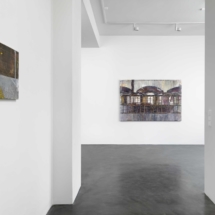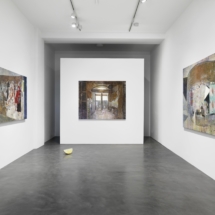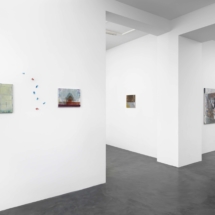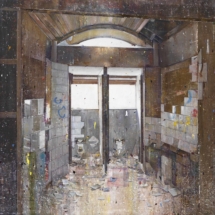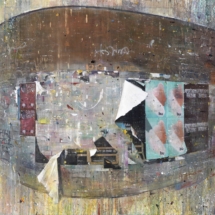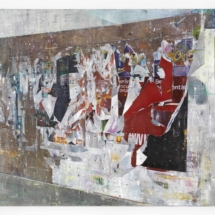Strange Days
Hyojun Hyun
Exhibition: 31 October - 28 November 2015
When I first saw Hyojun Hyun’s work in 2012, I sensed a special interest in very exact depictions of motifs found on wanderings through various cities. The bricks of a wall or the leaves of a tree were painted with utmost precision and patience. The paintings seemed to develop from an obsessive will to name things — through painting them — and it appeared that figurative painting was Hyun’s main interest. Within the painted scenes though, another interest was visible, since Hyun was painting locations with a somewhat deserted, messy or abandoned character: walls with graffiti, places taken over by decay or shaped by accidental events, and empty spaces without any people around. Even though Hyun was painting figuratively and in a seemingly realistic way, some kind of break down of the imagery was necessary in the work, because it was an integral part of the motifs that he chose to paint.
Through the years Hyun started to think about painting in a more abstract manner, for instance focusing on the accidental forms that arise while painting, or the drips that come down while working on a figurative scene. There were possibilities to be discovered in the process of painting that were not the result of a strong focus or the will to represent a particular scene, neither on the mastering of a certain skill. It seemed that painting could be expressive by itself, without everything being directed by the artist, just like a city could transmit moods of expression that were caused unintentionally, an accumulation of things without a clearly designed plan from a mastermind. Later on, Hyun also started to include painted objects in the presentation of his work. Or rather, objects that had paint on them. Small wooden bars that he had used in his studio to support a painting, and for that reason had paint on them, became small objects as such.
In Strange Days, his recent series of works presented at House of Egorn gallery in Berlin, Hyun's interest in figurative and abstract elements of painting seem to have joined forces and developed further. The images of deserted buildings or scenes from a city where time has taken over are still the result of having looked at a motif, having seen certain places and experienced their atmospheres. At the same time, if one zooms in on all the small details, the works can be regarded as developments in paint. The paint itself behaves quite freely, instead of serving the composition of the scene. Apart from the reality that was painted, the painting itself has become a reality.
Each of the bigger paintings in the exhibition shows a kind of architectural structure which is needed to make the scene work, to define a specific spot and create a sense of place and order, and to establish a connection with reality. We look at something that is familiar at first sight. Then, the further execution of the painting somehow counters this first structure, like a second voice. This process involves destruction, fading out of parts, mixing new details in, and the blending of colours. In the way that the paint is applied to the canvas, one cannot always be sure if it was the artist who deliberately painted a certain spot, or if it was the painting itself that took care of things.
text by Jurriaan Benschop
